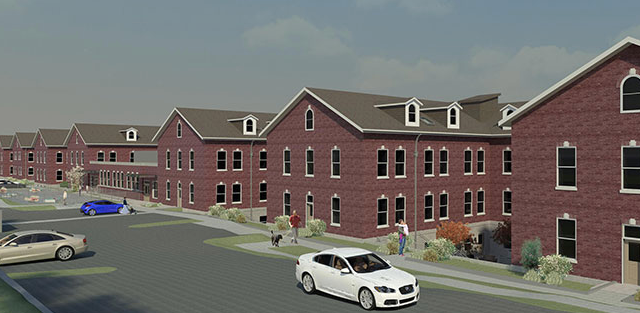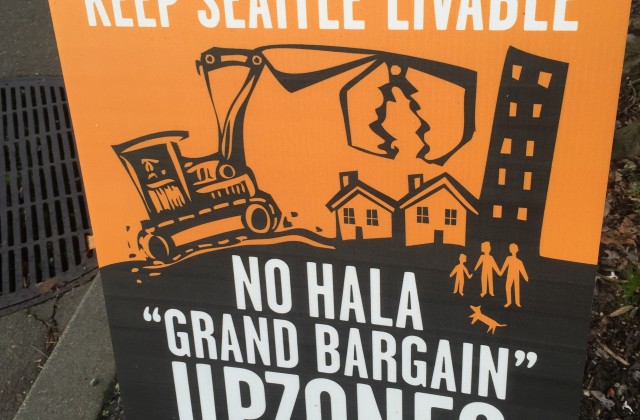Costs, Permitting, and Uncertainty: Outreach to Our New Mayor
Last week Jenny Durkan was sworn in as Seattle’s new Mayor. It is a historic moment since Durkan is the first woman to have the job in almost a century. She’s also got a big job managing expectations about growth and change in the city in the next decade. We’ve already been reaching out to her transition team. I’ve dusted off the letter we sent to Mayor Murray and the Council asking to work on reducing costs and uncertainty in the permitting process. We may not agree on the bigger issues associated with Mandatory Inclusionary Zoning (MIZ), but market rate and non-profits producers of housing face serious problems with how we permit housing. Here’s a quick email I sent to Mayor Durkan’s Deputy Mayor. Let’s hope we can work together in the year ahead.
Hello Mike,
On the Radio: $73 Million for 148 Units at Magnuson
Last Wednesday morning I was on the radio with Dave Ross talking about Mercy Housing $73 million rehab of 148 units at Building 9 of the decommissioned United States Navy barracks at Magnuson Park. Here’s Mercy Housing’s description of the project:
Building 9 will offer 148 apartments for working families and small households in the historic former Naval Air Station barracks. The project is located in the beautiful 350-acre Magnuson Park on Lake Washington with proximity to many resources including the Magnuson Community Center and Sand Point Elementary School. The adaptive reuse of this vacant building will preserve the exterior and key historic interior elements with an emphasis on energy efficiency resulting in beautiful, comfortable and affordable housing.
I have no doubt that for $73 million or about $493,243 per unit that the units will be “beautiful, comfortable” units. But why is it so expensive. One non-profit developer I heard from off the record agreed this cost, especially for a rhab not new construction is high.
I know lots of people think I’m mean for criticizing Mercy Housing and other non-profits. It’s not nice, they might think, to be hard on people trying to help poor people. But think about it: the more per unit that gets spent on this housing project is fewer dollars for other units that won’t get built. And when the money is not available, the non-profits have come after market rate builders to tax them to get the money. That means higher prices for market rate housing and then more demand for subsidized housing. That seems pretty mean to me, too. It’s really worse than mean, it’s wrong. Hopefully, the study we’ve asked for from the Joint Legislative Audit and Review Committee (JLARC) will shed some light on costs so that we can figure out how to make all housing more affordable.
You can listen to my about 5 minute interview with Dave Ross on the My Northwest podcast player.
Footnotes: Smart Growth Seattle Cited by Cato
When I was trying to be an academic back in my early twenties I learned the measuring rod for my work would be answering the question, “How many times have you been cited?” It was, frankly, a measure that was part of the reasons I left the profession. Judging my value by often being a footnote seemed, well, silly. But I get it. Citation means relevance. So we’re a little more relevant.
The Cato Institute’s Tax and Budget Bulletin No. 79 is called, “Low-Income Housing Tax Credit: Costly, Complex, and Corruption-Prone.”
Here we are, cited in the bulletin:
Smart Growth Seattle noted that “affordable housing projects have many unique costs, and often cost more because of financing, construction, and labor requirements. Affordable housing projects can be more expensive than market-rate due to some of these unique costs.”15 The head of that group, who is an expert on affordable housing, estimates that the per unit costs of LIHTC projects “can be more than double that of market rate housing.”16 He points to a 112-unit LIHTC complex in Seattle completed last year that cost $45 million, or $400,000 per unit.
This is an important bulletin and it’s a meaningful cite. And it matters that Cato uses “corrupt;” it’s a word I hesitate to use, but I often feel is appropriate to describe the cozy relationships and huge transfers and laundering of public money during the production of tax credit financed housing. It is a slow motion rip off.
I talked with one lawyer who admitted his wealth and the wealth of his firm was attributable to his and his firm’s willingness to venture into the complex world of tax credits. Good for them. I hope they enjoy their wealth attributable to hard work working the system; nothing wrong with that.
What bothers me, is that real people who build housing are cast as the villains by the left, while millionaire lawyers who profit from tax credit transactions are seen as lowering their mighty skills to help the poor. Nonsense. They’re paying bills like everyone else. There is a place where clear hypocrisy becomes so open that it defies the dictionary definition; making money from “helping the poor” isn’t a cover story, euphemism, or inconsistency, it’s standard operating procedure.
I’m proud to be cited by The Cato Institute. Cato the Younger, as I’ve said before, was the opponent of the Grand Bargains of his time. We are not a libertarian organization; rather we believe we are free because of good government, not because of its absence. Seattle lacks good government. And we’ll keep calling that out no matter what they call us.
The Three Powerful Myths Keeping MIZ Alive
I’ve been in Mexico on a last minute trip. Maybe I got too much sun. But I was suddenly struck with why Mandatory Inclusionary Zoning (MIZ) has been so hard to fight or even engage over. Both supporters and opponents just seem to fade away when they learn that people who build housing oppose MIZ and think it will just raise prices. There are three powerful myths that reinforce the conceptual framework around MIZ and make it so hard to break.
Myth 1
“Developers must pay their fair share!”
This is rooted in deeply doubts about supply and demand held by people who just don’t believe building will lower prices, but supporters who say they believe that but really don’t. Supply doubters think that if allowed to build like crazy, developers will keep raising prices, and we’ll get more high priced housing.
The supposed supply siders say things like, “Sure, we need more supply, but the market can’t possibly solve the problem.” This view is held by many “Urbanists” who don’t want to sound like Republicans or libertarians, even though nobody I know (including me) argues the market will “solve the problem problem” whatever that means.
The MIZ scheme allows for Urbanist types to say, “We get more density!” And for supply deniers, the notion that onerous fees will stifle new projects or squeeze developer profits is satisfying.
The Truth:
More housing supply will have an ameliorative impact on prices by better meeting demand for newcomers and creating competition between sellers and between typologies. More housing means an apartment dweller can afford a single-family house, opening up her apartment for a new comer that won’t displace a person in a down market rental.
It’s worth noting that before he unlearned what he knew about MIZ and relearned it while at the Sightline Institute, Dan Bertolet wrote the definitive take down of this myth at Publicola.
Myth 2
“We need more affordable housing!”
If you deny supply’s benefits then it’s obvious that the market will just keep producing expensive products, even if there becomes a glut of them. One funny but persistent ghost story is the one about developers leaving their buildings empty rather than lowering prices. That means subsidized housing funded from the exactions taken from developer profits (see above) is satisfying. Robin Hood will steal from the rich and give to the poor.
For weak principled supply supporters this is mostly sloppy language. Some mean More supply and more housing will lower prices, but most also believe that somehow, non-profit producers sort of know what they’re doing, they just don’t have enough money. Taxing new housing and skimming profits is like any other tax, and progressives like taxes. “If we had an income tax,” some counter, “we could take those ill gotten gains and give them to non-profits; but we have an unfair tax system. Sad!”
The Truth:
We don’t need more affordable housing, we need more housing so that it is affordable. The implications of this shift in language matter. We don’t know at what point the market would fail to produce housing that some levels of income couldn’t pay for; that is unless and until we get out of the way of buyers and sellers, we won’t know who was “priced out.”
We have a pretty good idea of who can’t pay rent; a person with zero income or $12,000 in social security income is clearly never going to be able to afford housing in Seattle or much else. But a 22 year old college graduate paying 50 percent of his income on a microhousing unit is probably a perfect solution; he has fewer expenses, location means more than unit size, and he’s moving up one would guess in the economy. It would be wasteful and silly to heavily subsidize him or have him compete for housing with truly poor people.
The market figures these things out of there is lots of supply. Microhousing is a great example of how the innovation of the market can ease competition between consumers not just with lower prices but more selection of type and location of housing.
Myth 3
“The Grand Bargain is a compromise!”
This drives the angry neighbors, slow growthers, and communists crazy. The notion of the Grand Bargain as an agreement between a cabal of developers and City bureaucrats fuels their anger; but it reenforces the notion that the Bargain just set fees and requirements too low, otherwise why would developers agree to it. This means the supply deniers don’t want an end to MIZ, but a hand in dialing up exactions so that nothing gets built or that it is at least expensive and puts money in their control through turning the ransom for building permits over to the City where they have influence over how it’s spent.
For Urbanists, people who love to chat and talk about housing and economic theory, compromise means more chit chat and theory. Compromise is also part of their value system that derives from academia and planning professions. The notion is that the Grand Bargain somehow, in theory, is a win win; people who actually build housing get more square footage and profit, the Urbanists get density in the abstract, and non-profit colleagues get cash to keep doing socially beneficial things.
The Truth:
The simple facts are that the Grand Bargain was drawn up but a few big developers, their lawyers and lobbyists, City bureaucrats, and non-profit developers. The people who build, operate, and understand housing across typologies and locations in the city weren’t involved at all. Neither were angry neighbors that are mostly supply deniers. The socialists and communists weren’t involved either.
What the architects of the Grand Bargain did wisely account for was the narrative frame. They new nobody would listen to developers not part of the deal if they complained. After all, those people are greedy and only want profits. The MIZ scheme central to the Bargain is the narrative of the “fair share.”
The people behind the Bargain also new that most ordinary people share the view that “we need more affordable housing.” As I’ve pointed out, the person on the street thinks that market rate housing whether single-family or multifamily will never be affordable for working class or poor people. Government had to intervene and squeeze something from wealthy developers for production of subsidized housing.
The Grand Bargain was a compromise the way a successful hostage negotiation with an exchange of the prisoner and he cash is a “compromise.” That would all have been fine with me anyway had not all the developers not in the room been expected to pay the ransom. It’s like finding out that hostage you read about in the paper was freed because someone handed over the passwords to your bank and retirement accounts.
Cerberus: The Vicious Three Headed Dog of MIZ
Of course I’m using the term “myth” in the popular sense of something not true, not the classical sense. But this three part structure does remind me of a an actual myth, the story of Cerberus, the three headed dog guarding the gates of Hell. Cerberus would let the dead pass but not let them out. Overpowering and capturing Cerberus was Hercules final task.
I wish Hercules was around now. These three deeply held narratives mean the Grand Bargain has strength and momentum. Any one of them, on their own, is a challenge to overcome. Put them together and it’s easy to see why such a bad idea is still bearing its teeth and barking loudly.
Good News? Neighborhood Groups Launch Appeal of MIZ
Well, it’s no surprise that neighborhood groups are cranking up their appeal machine to go after Mandatory Inclusionary Zoning (MIZ) or as the City terms it, Mandatory Housing Affordability (MHA). Hallelujah! That’s right, we must cheer them on. As I’ve pointed out many times, we dislike MIZ as much if not more than angry neighbors. It is a disastrous policy that will raise overall housing prices to funnel cash to inefficient non-profit producers of housing. Why would Builders and developers agree with the neighborhood appeal? That’s the man bites dog story nobody wants to talk about.
Neither Builders and developers who produce the vast majority of housing in Seattle nor neighborhood groups were involved or consulted about the Grand Bargain. For people who produce housing, additional buildable square footage offered by the Mandatory Housing Affordability (MHA) program created by the Bargain is canceled or exceeded by the costs of the fees and extra construction costs. For most people who make housing, MHA isn’t a bargain at all but an additional cost they’ll have to pass on with higher prices.
Only a few big, corporate developers signed the Grand Bargain. The hard working, family run businesses that make everything from single-family homes to mid-rise apartments don’t want this proposal to move forward. It’s hard enough to build housing today, with more and more rules and costs being added all the time. The Mayor and Council should stop this effort and simply allow the experts in design and construction make more housing.
The neighborhood groups appealing have views that are antithetical to more supply; they are, in fact, the drivers of most of the onerous regulation boosting costs and prices now. However, they are right about one thing: there was no consideration made of how the MHA proposal would be received in neighborhoods. City Hall hasn’t listened to our concerns; perhaps they’ll listen to a judge responding to this appeal.
And maybe the local media and press, incurious up till now, might scratch their heads and ask why a rentless campaigner for more housing like me would be pleased, happy even, that the same neighbors who killed small-lot development, microhousing, and ruined many opportunities in zones with abundant housing potential (low-rise zones) are trying to kill an uupzone proposal.
As I’ve chronicled, I’ve been around a long time. I have never in 20 years seen anything like the MIZ/MHA boondoggle. Someone would be eligible for some kind of award for pulling this off. But the whole thing is what Hannah Arendt described as the banality of evil; so many people assume developers want more density and that solving housing price is the same thing as building expensive subsidized housing, that it just seems obvious that the Grand Bargain really is a compromise. It isn’t. It is a slow motion rip off of people who actually pay rent and mortgages in the city.
Smart, well intended people have gone along with this debacle because, well, people said it’s a compromise, right? More market rate housing and some funds for subsidized housing. What could be wrong about that? The beauty of the neighborhood appeal is that it throws a monkey wrench into the rapidly spinning wheels of MIZ; and these are the people that strike fear in the hearts of skittish Councilmembers. If we appealed it, the Council and press would just hand wave our appeal: it’s about profits, they’d say. The greedy developer myth is deeply embedded in the Seattle psyche.
What is the likely outcome? Well, hopefully the appeal begins the process of dropping the MIZ mess into the fires of Mount Doom — even if it’s for the wrong reasons (opposing growth and change). Angry neighbors have more sway in this town over housing policy than people who actually build housing. The other big dogs are the non-profits and socialists. I’m happy to sit back and watch them fight it out while MIZ sits on the shelf, or slowly falls apart.






